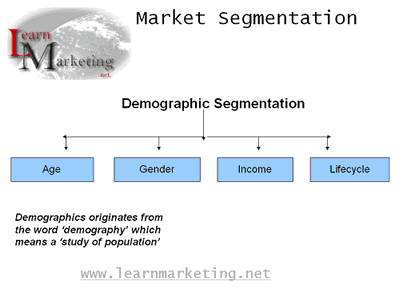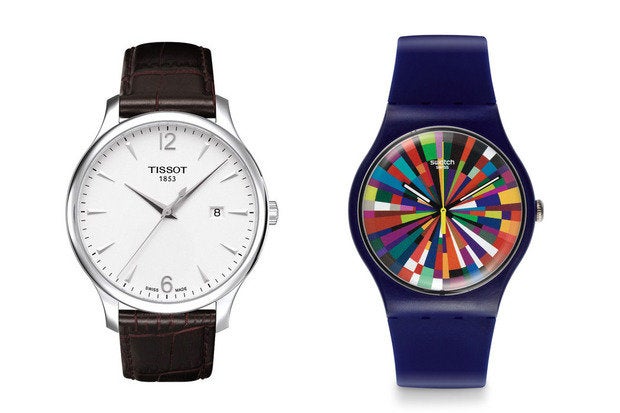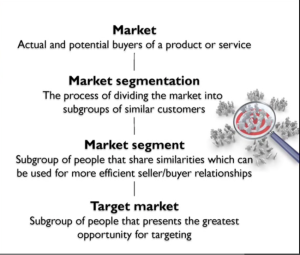Designers must consider the market when targeting their product, service or system. The smaller the sector, the more the target audience will have in common. Companies may decide to compete in the whole market or only in segments that are attractive and/or familiar. A designer’s understanding of the identified market is essential.
By identifying the market sectors and segments a product will be designed for, a designer can gain data directly from the perspective of the potential consumer.
Market Sector
Market Sector: A broad way of categorizing the kinds of market the company is aiming for.
Categories of market sectors
Designers need to clearly be able to identify the needs of the target market and target audience. These can be classified into two categories:
- Geographical sectors, which focus on the values, culture and characteristics of purchasers in that region along with purchasing power
- Consumer needs vary between climatic regions where block heaters are used in Canada which would be of little use in Egypt
- Client-based sectors, which may focus on consumers, industrial, public sector and commercial.
- Watchmakers target income groups such as Tissot vs Swatch.
- List of Sectors from yahoo. Click on the sector and you will see smaller sections.
The influence of market sectors
- if there is a technological advance then the products or services in that sector will change.
- This change will influence the target markets.
- Such as the size of microchips allowing for powerful portable devices leading to iPads and smartphones.
Products in Sectors
- Products designed to be sold in one sector for example laptops would fall under the technology sector.
- Products designed to be sold to more than one sector for example an iPhone – technology and telecommunication sectors.
- How multinational companies take into account market sectors in the design and manufacture of their products.
The difference between a market sector and market segment
- Market sector is a broad way of categorising the kinds of market the company is aiming for. The sectors have similar characteristics such a technology, utilities, telecommunications etc
- Market sector explained on investopedia
- Market segment is dividing up the markets into smaller segments targeting customers that share characteristics.
- They interact with one another by nature of their characteristics. Technology sector would govern who the segments are targeting, i.e. early adopters, gamers, etc. This in turn could influence the direction of the companies in the sector head.
Classifications of consumer market segments
- Maket segmentation: Markets divided in to smaller segments where purchasers have similar characteristics and/or tastes.
- Market segmentation described by the Open University. Explains well why and how businesses can target segments.
- A slideshare an intern on market segmentation.
- The fact that the consumer market is divided in segments allows companies and organisations to develop promotional campaigns targeting specific segments.
- For example business people for business class on airlines or executive automobiles.
- This means the company can develop products that better suit the consumer of segment.
Types of Market Segments
- income (high, middle and low levels of finance) – Daewoo and Corolla vehicles for price sensitive customers whereas Mercedes and BMW aim their cars at the more affluent.
- profession (types of jobs one has which can influence social groups or personal interests) – marketing e-book for executives,
- age (babies, toddlers, tweens, teenagers, young adults, middle aged to the elderly) – such as diapers/nappies for babies, toys for children, clothes for teenagers
- family – (single no kids, single kids, married two kids, empty nesters etc) – a family with kids would purchase furniture that is more family orientated as opposed to a single living alone (trendy furniture).
- values (the ethical, worthiness or importance of something that is held by an individual or group, opinions) – environmentally friendly products vs a throw away society.
- behaviour (shopping mannerisms, loyalty, occasion buying, such as impulsive, online vs brick ‘n mortar, or the researcher) – buying turkeys at christmas and thanksgiving (occasion buying), Apple customers (loyalty),
- An idea list for segments – by no means an exhaustive list

How the needs of the market segments listed above impact on the design of products and scale of production.
- In China there is a need of low cost street commuter bicycles (no gears, basket, simple brakes) to cater for a market segment of low income earners which is a large target market. The scale of production would be that of volume.
- Mont Blanc pens target a market segment of middle to high income earners and possibly business men and women. These would be batch produced. The cheapest at an UK online pen store in April 2015 was £170. Whereas a a box of 60 Bic pens in the USA costs $15. These would be volume produced.
The development of a product family
Product family: A group of products having common classification criteria. Members normally have many common parts, assemblies and/or aesthetic elements.
Companies and designers will develop a successful product or product range into product families. This further develops a successful market segment that is already familiar with the original product. For example, iPod then IPhone,, then iPad.
Designers often develop product families to extend a successful product range and to develop products for market segments that are already familiar with the original product.


International-mindedness:
Two broad categories of market sectors are geographical- and client-based, with specific segments varying greatly.
Theory of knowledge:
Gaining information on market sectors often employs many of the methods of gaining knowledge most closely associated with the human sciences. What are these methods of gaining knowledge, and how do they compare to the methods used in the natural sciences?
Something Extra


Designers must consider the market when targeting their product, service or system. The smaller the sector, the more the target audience will have in common. Companies may decide to compete in the whole market or only in segments that are attractive and/or familiar. A designer’s understanding of the identified market is essential.
By identifying the market sectors and segments a product will be designed for, a designer can gain data directly from the perspective of the potential consumer.
Market Sector
Market Sector: A broad way of categorizing the kinds of market the company is aiming for.
Categories of market sectors
Designers need to clearly be able to identify the needs of the target market and target audience. These can be classified into two categories:
- Geographical sectors, which focus on the values, culture and characteristics of purchasers in that region along with purchasing power
- Consumer needs vary between climatic regions where block heaters are used in Canada which would be of little use in Egypt
- Client-based sectors, which may focus on consumers, industrial, public sector and commercial.
- Watchmakers target income groups such as Tissot vs Swatch.
- List of Sectors from yahoo. Click on the sector and you will see smaller sections.

The influence of market sectors
- if there is a technological advance then the products or services in that sector will change.
- This change will influence the target markets.
- Such as the size of microchips allowing for powerful portable devices leading to iPads and smartphones.
Products in Sectors
- Products designed to be sold in one sector for example laptops would fall under the technology sector.
- Products designed to be sold to more than one sector for example an iPhone – technology and telecommunication sectors.
- How multinational companies take into account market sectors in the design and manufacture of their products.
The difference between a market sector and market segment
- Market sector is a broad way of categorising the kinds of market the company is aiming for. The sectors have similar characteristics such a technology, utilities, telecommunications etc
- Market sector explained on investopedia
- Market segment is dividing up the markets into smaller segments targeting customers that share characteristics.
- They interact with one another by nature of their characteristics. Technology sector would govern who the segments are targeting, i.e. early adopters, gamers, etc. This in turn could influence the direction of the companies in the sector head.
Classifications of consumer market segments
- Maket segmentation: Markets divided in to smaller segments where purchasers have similar characteristics and/or tastes.
- Market segmentation described by the Open University. Explains well why and how businesses can target segments.
- A slideshare an intern on market segmentation.
- The fact that the consumer market is divided in segments allows companies and organisations to develop promotional campaigns targeting specific segments.
- For example business people for business class on airlines or executive automobiles.
- This means the company can develop products that better suit the consumer of segment.
Types of Market Segments
- income (high, middle and low levels of finance) – Daewoo and Corolla vehicles for price sensitive customers whereas Mercedes and BMW aim their cars at the more affluent.
- profession (types of jobs one has which can influence social groups or personal interests) – marketing e-book for executives,
- age (babies, toddlers, tweens, teenagers, young adults, middle aged to the elderly) – such as diapers/nappies for babies, toys for children, clothes for teenagers
- family – (single no kids, single kids, married two kids, empty nesters etc) – a family with kids would purchase furniture that is more family orientated as opposed to a single living alone (trendy furniture).
- values (the ethical, worthiness or importance of something that is held by an individual or group, opinions) – environmentally friendly products vs a throw away society.
- behaviour (shopping mannerisms, loyalty, occasion buying, such as impulsive, online vs brick ‘n mortar, or the researcher) – buying turkeys at christmas and thanksgiving (occasion buying), Apple customers (loyalty),
- An idea list for segments – by no means an exhaustive list

How the needs of the market segments listed above impact on the design of products and scale of production.
- In China there is a need of low cost street commuter bicycles (no gears, basket, simple brakes) to cater for a market segment of low income earners which is a large target market. The scale of production would be that of volume.
- Mont Blanc pens target a market segment of middle to high income earners and possibly business men and women. These would be batch produced. The cheapest at an UK online pen store in April 2015 was £170. Whereas a a box of 60 Bic pens in the USA costs $15. These would be volume produced.
The development of a product family
Product family: A group of products having common classification criteria. Members normally have many common parts, assemblies and/or aesthetic elements.
Companies and designers will develop a successful product or product range into product families. This further develops a successful market segment that is already familiar with the original product. For example, iPod then IPhone,, then iPad.
Designers often develop product families to extend a successful product range and to develop products for market segments that are already familiar with the original product.


International-mindedness:
Two broad categories of market sectors are geographical- and client-based, with specific segments varying greatly.
Theory of knowledge:
Gaining information on market sectors often employs many of the methods of gaining knowledge most closely associated with the human sciences. What are these methods of gaining knowledge, and how do they compare to the methods used in the natural sciences?
Something Extra
http://www.dobney.com/images/segmentation.jpg


